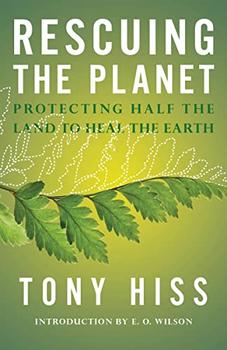Summary | Excerpt | Reviews | Beyond the Book | Readalikes | Genres & Themes | Author Bio

Critics' Opinion:
Readers' Opinion:
First Published:
Mar 2021, 320 pages
Paperback:
Mar 2022, 320 pages
 Book Reviewed by:
Book Reviewed by:
Norah Piehl
Buy This Book
There's another layer to 50 by '50, something happening inside people, not just around them. Only about 570 people have had a chance to leave the earth and look back at it, either from the moon or the International Space Station or an orbiting spaceship. Some of them, like NASA astronaut Ron Garan, who spent six months on the ISS, have talked about the experience as life-changing. In "Overview," a video posted on Vimeo that's had more than 8 million views, Garan says, "When we look down at the earth from space, we see this amazing, indescribably beautiful planet. It looks like a living, breathing organism. But it also at the same time looks extremely fragile."
Another NASA astronaut in the video, Jeff Hoffman, who's logged 1,211 hours in space and is now an MIT professor, says, "You go outside on a clear day and it's the big blue sky, and it's like it goes on forever," and yet from space, "it's this thin line that's just barely hugging the surface of the planet." Garan calls it "really sobering" to see how paper-thin this living layer of the planet—the biosphere—is, realizing it's the only thing "that protects every living thing on earth from death, basically." In 1969 Michael Collins was on Apollo 11, the first spacecraft to land on the moon. Fifty years later Collins spoke to The New York Times about his view of the earth: "I had a feeling it's tiny, it's shiny, it's beautiful, it's home, and it's fragile." Frank White, an American writer on space exploration, calls this new understanding "the Overview Effect." This book is also about opening up to the Overview Effect while still down below.
It isn't so much that we have an affinity for the rest of life, though we do. It's that when danger threatens, it threatens all alike. Here, in the biosphere, a place that has sheltered life for 3.5 billion years, every species shares the same precarious circumstances. More than seven hundred years ago, the Persian poet Jalaluddin Rumi wrote, "Because of necessity, man acquires organs. So, necessitous one, increase your need." In the twenty-first century, need will keep us on our toes at every moment.
In many ways, the mass extinction crisis and the climate crisis are inseparable in the Boreal Forest, since its trees are at once bird rich and carbon rich. Billions of songbirds and shorebirds, some from as far away as South America, come there every spring to nest. The forest and its soil store ("sequestration" is the technical word) billions of tons of carbon that if released into the air would accelerate the warming of the earth. Which is why the Boreal has two nicknames: "North America's bird nursery" and "the Fort Knox of carbon." The North American Boreal Forest, mostly in Canada, partly in Alaska, is the largest and most intact wildness left in the world. On my boat ride in the Boreal I was merely bumping through a gigantic sliver of its breath-catching immensity.
How big is it exactly? Details don't really do it justice when you're in the middle of it way up north, where everything seems bigger anyway, more ancient and undiminished, a place where you're always face-to-face with overarching ecological, hydrological, biological, and atmospheric patterns. But here are a few details: at about 3,700 miles long, the Boreal is a thousand miles longer than the distance from New York to Los Angeles, and north to south (top to bottom) it's up to a thousand miles thick, and altogether it takes up almost as much space as three-quarters of the Lower 48 states. Most essentially, this is a peopled wilderness, and has been for thousands of years, its health and abundance maintained, managed, and participated in by more than six hundred Indigenous communities.
I was with some of these people on the boat. Two of them happened to be not just Steves but Steve Ks. The first was a frequent visitor to the Boreal—Steven Kallick, an environmental and human rights lawyer from outside Chicago, who now lives in Seattle and is the director of the International Boreal Conservation Campaign. For twenty years he's been helping build an unexpected—because, really, who would've guessed it?—bicontinental approach to land conservation that has Indigenous groups in the Northwest Territories and across Canada cooperating with Aboriginal allies nine thousand miles away in the Australian outback. A century and a half after Yellowstone, people along this still practically invisible British Commonwealth axis are inventing a post-Thoreauvian, "plus-one" kind of national park, wildnesses that permanently embrace all their plants and animals—plus their human inhabitants. Who (it bears repeating) never left.
Excerpted from Rescuing the Planet by Tony Hiss. Copyright © 2021 by Tony Hiss. All rights reserved. No part of this excerpt may be reproduced or reprinted without permission in writing from the publisher.





The Flower Sisters
by Michelle Collins Anderson
From the new Fannie Flagg of the Ozarks, a richly-woven story of family, forgiveness, and reinvention.

The House on Biscayne Bay
by Chanel Cleeton
As death stalks a gothic mansion in Miami, the lives of two women intertwine as the past and present collide.

The Funeral Cryer by Wenyan Lu
Debut novelist Wenyan Lu brings us this witty yet profound story about one woman's midlife reawakening in contemporary rural China.
Your guide toexceptional books
BookBrowse seeks out and recommends the best in contemporary fiction and nonfiction—books that not only engage and entertain but also deepen our understanding of ourselves and the world around us.